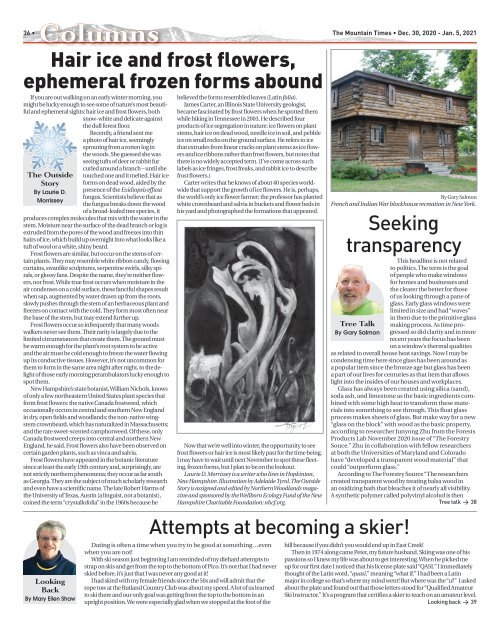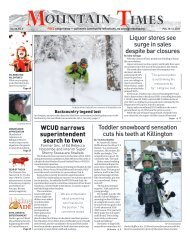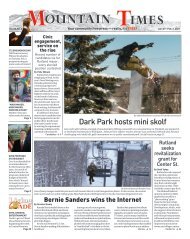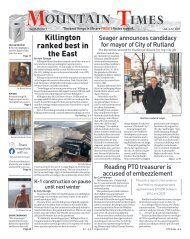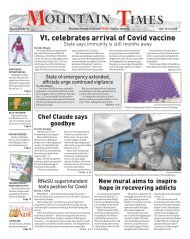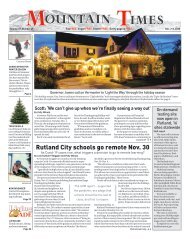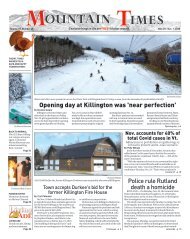Mountain Times - Vol. 49, No. 53 - Dec. 30, 2020 - Jan 2, 2021
You also want an ePaper? Increase the reach of your titles
YUMPU automatically turns print PDFs into web optimized ePapers that Google loves.
Columns<br />
36 • The <strong>Mountain</strong> <strong>Times</strong> • <strong>Dec</strong>. <strong>30</strong>, <strong>2020</strong> - <strong>Jan</strong>. 5, <strong>2021</strong><br />
Hair ice and frost flowers,<br />
ephemeral frozen forms abound<br />
If you are out walking on an early winter morning, you<br />
might be lucky enough to see some of nature’s most beautiful<br />
and ephemeral sights: hair ice and frost flowers, both<br />
snow-white and delicate against<br />
the dull forest floor.<br />
Recently, a friend sent me<br />
a photo of hair ice, seemingly<br />
sprouting from a rotten log in<br />
the woods. She guessed she was<br />
seeing tufts of deer or rabbit fur<br />
The Outside<br />
Story<br />
By Laurie D.<br />
Morrissey<br />
curled around a branch – until she<br />
touched one and it melted. Hair ice<br />
forms on dead wood, aided by the<br />
presence of the Exidiopsis effusa<br />
fungus. Scientists believe that as<br />
the fungus breaks down the wood<br />
of a broad-leafed tree species, it<br />
produces complex molecules that mix with the water in the<br />
stem. Moisture near the surface of the dead branch or log is<br />
extruded from the pores of the wood and freezes into thin<br />
hairs of ice, which build up overnight into what looks like a<br />
tuft of wool or a white, shiny beard.<br />
Frost flowers are similar, but occur on the stems of certain<br />
plants. They may resemble white ribbon candy, flowing<br />
curtains, swanlike sculptures, serpentine swirls, silky spirals,<br />
or glossy fans. Despite the name, they’re neither flowers,<br />
nor frost. While true frost occurs when moisture in the<br />
air condenses on a cold surface, these fanciful shapes result<br />
when sap, augmented by water drawn up from the roots,<br />
slowly pushes through the stem of an herbaceous plant and<br />
freezes on contact with the cold. They form most often near<br />
the base of the stem, but may extend further up.<br />
Frost flowers occur so infrequently that many woods<br />
walkers never see them. Their rarity is largely due to the<br />
limited circumstances that create them. The ground must<br />
be warm enough for the plant’s root system to be active<br />
and the air must be cold enough to freeze the water flowing<br />
up its conductive tissues. However, it’s not uncommon for<br />
them to form in the same area night after night, to the delight<br />
of those early morning perambulators lucky enough to<br />
spot them.<br />
New Hampshire’s state botanist, William Nichols, knows<br />
of only a few northeastern United States plant species that<br />
form frost flowers: the native Canada frostweed, which<br />
occasionally occurs in central and southern New England<br />
in dry, open fields and woodlands; the non-native wingstem<br />
crownbeard, which has naturalized in Massachusetts;<br />
and the rare sweet-scented camphorweed. Of these, only<br />
Canada frostweed creeps into central and northern New<br />
England, he said. Frost flowers also have been observed on<br />
certain garden plants, such as vinca and salvia.<br />
Frost flowers have appeared in the botanic literature<br />
since at least the early 19th century and, surprisingly, are<br />
not strictly northern phenomena; they occur as far south<br />
as Georgia. They are the subject of much scholarly research<br />
and even have a scientific name. The late Robert Harms of<br />
the University of Texas, Austin (a linguist, not a botanist),<br />
coined the term “crystallofolia” in the 1960s because he<br />
Looking<br />
Back<br />
By Mary Ellen Shaw<br />
believed the forms resembled leaves (Latin folia).<br />
James Carter, an Illinois State University geologist,<br />
became fascinated by frost flowers when he spotted them<br />
while hiking in Tennessee in 2003. He described four<br />
products of ice segregation in nature: ice flowers on plant<br />
stems, hair ice on dead wood, needle ice in soil, and pebble<br />
ice on small rocks on the ground surface. He refers to ice<br />
that extrudes from linear cracks on plant stems as ice flowers<br />
and ice ribbons rather than frost flowers, but notes that<br />
there is no widely accepted term. (I’ve come across such<br />
labels as ice fringes, frost freaks, and rabbit ice to describe<br />
frost flowers.)<br />
Carter writes that he knows of about 40 species worldwide<br />
that support the growth of ice flowers. He is, perhaps,<br />
the world’s only ice flower farmer; the professor has planted<br />
white crownbeard and salvia in buckets and flower beds in<br />
his yard and photographed the formations that appeared.<br />
<strong>No</strong>w that we’re well into winter, the opportunity to see<br />
frost flowers or hair ice is most likely past for the time being.<br />
I may have to wait until next <strong>No</strong>vember to spot these fleeting,<br />
frozen forms, but I plan to be on the lookout.<br />
Laurie D. Morrissey is a writer who lives in Hopkinton,<br />
New Hampshire. Illustration by Adelaide Tyrol. The Outside<br />
Story is assigned and edited by <strong>No</strong>rthern Woodlands magazine<br />
and sponsored by the Wellborn Ecology Fund of the New<br />
Hampshire Charitable Foundation: nhcf.org.<br />
Dating is often a time when you try to be good at something…even<br />
when you are not!<br />
With ski season just beginning I am reminded of my diehard attempts to<br />
strap on skis and get from the top to the bottom of Pico. It’s not that I had never<br />
skied before, it’s just that I was never any good at it!<br />
I had skied with my female friends since the 50s and will admit that the<br />
rope tow at the Rutland Country Club was about my speed. A lot of us learned<br />
to ski there and our only goal was getting from the top to the bottom in an<br />
upright position. We were especially glad when we stopped at the foot of the<br />
By Gary Salmon<br />
French and Indian War blockhouse recreation in New York.<br />
transparency<br />
This headline is not related<br />
to politics. The term is the goal<br />
of people who make windows<br />
for homes and businesses and<br />
the clearer the better for those<br />
of us looking through a pane of<br />
glass. Early glass windows were<br />
limited in size and had “waves”<br />
Tree Talk<br />
By Gary Salmon<br />
Seeking<br />
in them due to the primitive glass<br />
making process. As time progressed<br />
so did clarity and in more<br />
recent years the focus has been<br />
on a window’s thermal qualities<br />
as related to overall house heat savings. <strong>No</strong>w I may be<br />
condensing time here since glass has been around as<br />
a popular item since the bronze age but glass has been<br />
a part of our lives for centuries as that item that allows<br />
light into the insides of our houses and workplaces.<br />
Glass has always been created using silica (sand),<br />
soda ash, and limestone as the basic ingredients combined<br />
with some high heat to transform these materials<br />
into something to see through. This float glass<br />
process makes sheets of glass. But make way for a new<br />
“glass on the block” with wood as the basic property,<br />
according to researcher Junyong Zhu from the Forests<br />
Products Lab <strong>No</strong>vember <strong>2020</strong> issue of “The Forestry<br />
Souce.” Zhu in collaboration with fellow researchers<br />
at both the Universities of Maryland and Colorado<br />
have “developed a transparent wood material” that<br />
could “outperform glass.”<br />
According to The Forestry Source “The researchers<br />
created transparent wood by treating balsa wood in<br />
an oxidizing bath that bleaches it of nearly all visibility.<br />
A synthetic polymer called polyvinyl alcohol is then<br />
Attempts at becoming a skier!<br />
Tree talk > 38<br />
hill because if you didn’t you would end up in East Creek!<br />
Then in 1974 along came Peter, my future husband. Skiing was one of his<br />
passions so I knew my life was about to get interesting. When he picked me<br />
up for our first date I noticed that his license plate said “QASI.” I immediately<br />
thought of the Latin word, “quasi,” meaning “what if.” I had been a Latin<br />
major in college so that’s where my mind went! But where was the “u?” I asked<br />
about the plate and found out that those letters stood for “Qualified Amateur<br />
Ski Instructor.” It’s a program that certifies a skier to teach on an amateur level.<br />
Looking back > 39


